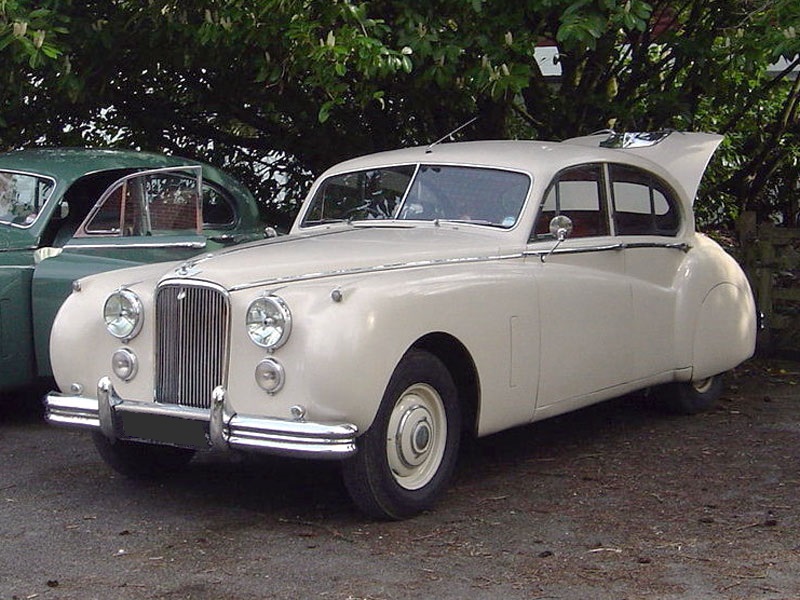-
Insurance
InsuranceAbout our productsLearn about insuringGet a quote Get current values, historical values, model history and more.
-
Valuation
ValuationHagerty valuation toolLook up a vehicle value Get current values, historical values, model history and more.
-
Events
EventsHagerty official eventsHagerty ClubhouseEvent calendar
-
Entertainment
EntertainmentMore to explore
- Portal login
1952 Jaguar Mark VII
Base 4dr Saloon 3.4 L
Vehicle values by condition
Fair
Condition 4
£12,600
#4 cars are daily drivers, with flaws visible to the naked eye. The chrome might have pitting or scratches, the windshield might be chipped.
Good
Condition 3
£19,200
#3 cars could possess some, but not all of the issues of a #4 car, but they will be balanced by other factors such as a fresh paint job or a new, correct interior.
Excellent
Condition 2
£33,400
#2 cars could win a local or regional show. They can be former #1 cars that have been driven or have aged. Seasoned observers will have to look closely for flaws.
Concours
Condition 1
£38,600
#1 vehicles are the best in the world. The visual image is of the best car, unmodified, in the right colours, driving onto the lawn at the finest concours.
Insurance premium for a
1952 Jaguar Mark VII Base 4dr Saloon 3442
valued at £19,200
£148.34
/ year*
History of the 1951 - 1954 Jaguar Mark VII

1951 - 1954 Jaguar Mark VII
The Jaguar Mk VII is a magnificent five-seat, rear-wheel-drive sporting saloon powered by a 3.4-litre I-6 DOHC engine with independent torsion bar suspension at the front, semi-elliptic leaf springs at the rear, and servo assisted drum brakes. Plus, it has stetely coachwork that imparts a dignified presence.
Jaguar commenced development of the Mk VII during the Second World War, and when it debuted in October 1950 it was the first car with a mass-produced twin-cam engine. The chassis and transmission were derived from its Mk V predecessor, but the styling was markedly different. Jaguar moved directly to the Mk VII badge as Bentley already had a Mk VI on the market. The price was £1,616, which was deemed by press and public alike as quite remarkable for a car that could travel at 101mph and came with fog lamps, adjustable steering, a sliding roof and a heater as standard. Early examples can be recognised via their footwell air vents.
In 1952, the Jaguar Mk VII was fitted with two-speed wipers and the price was now £1,693 18s 11d. Automatic transmission became an extra for 1953 model cars – a first for Jaguar and essential for sales in the all-important US market. Automatic Mk VIIs were initially for export only, with a selector lever mounted on the dashboard and a front bench seat. Meanwhile great publicity accrued from the race victories in the Silverstone International Trophy Production Touring Car race – Stirling Moss took first place in 1952 and 1953, Ian Appleyard in 1954, Mike Hawthorn in 1955 and Ivor Bueb in 1956.
Overdrive was available from January 1954 onwards and the Mk VII was superseded by the Jaguar Mk VIIM that October. The fog lamps were now mounted on the bumpers rather than recessed into the front panels and the trafficators were replaced by flashing indicators (amber at the front, combined with the stop/tail lamps at the rear). There was also a close ratio gearbox, the suspension now had stiffer torsion bars, and the engine was improved with an enhanced compression ratio and high-lift camshafts, resulting in 90bhp as opposed to the Mk VII’s 160bhp. This was the Jaguar that famously won the Monte Carlo Rally in 1956; a high note before it was replaced by the Mk VIII in the autumn of that year.
The heart of the Mk VII is, of course, Jaguar’s 3,442cc XK engine and the standard transmission was the 4-speed ‘Moss’ gearbox with synchromesh on the top three ratios. The overdrive is from Laycock de Normanville operating on fourth gear and the automatic box is the 3-speed Borg Warner DG unit.
By modern standards the Jaguar Mk VII does roll and will feel heavy at low speeds, but in the context of early 1950s motoring, it was a genuine revelation in terms of acceleration, cruising ability, road manners, and braking. Some Jaguar enthusiasts regard the interior as reason enough for investing in a Mk VII and many like to drive with the sunroof open, the better to hear the music from that XK power plant.
As with virtually all Jaguars of this era, rust can be problematic; investigate the sills, the front wings, around the fuel tanks, the rear valance, chassis outriggers, the pillars, and the sunroof gutters. The automatic transmission can be prone to leak oil and too much blue smoke from the exhaust could denote a future, and costly, bottom end rebuild.
The fact that the Jaguar XK120 was intended as a testbed for the 3.4-litre engine before the launch of the Mk VII is well-known but is always worth repeating, as this is the Jaguar that set the template for all of the company’s subsequent saloons. Whether you are an aficionado of classic racing, B-films (the Mk VII was a star of many a black-and-white crime drama) or seminal British cars, you will find the big Jaguar incredibly rewarding.
The Jaguar Mk VII offered performance and luxury to compete with the Rolls-Royce Silver Dawn and Silver Cloud, the Daimler Regency and the Lagonda 2.6 -litre, yet sold at a price to tempt Rover and Humber buyers. Perhaps its closest rival was the Armstrong-Siddeley Sapphire 346.
Hagerty Newsletter
Get your weekly dose of car news from Hagerty UK in your inbox

ADVERTISEMENT